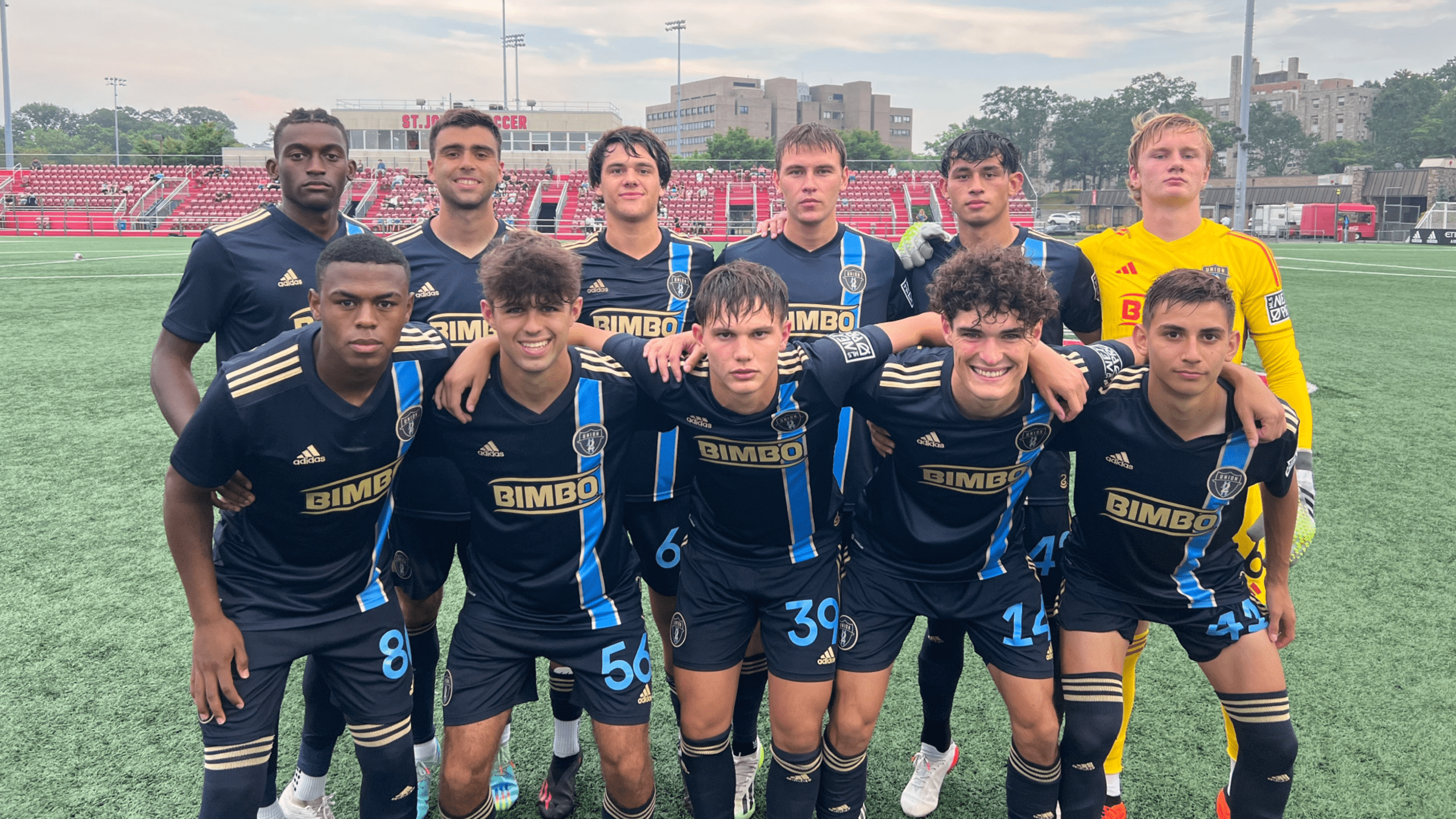Photo courtesy Philadelphia Union II
This season the most interesting Union II position to watch has been defensive center mid, especially lately.
Except for 135 minutes of 2022, all last season head coach Marlon LeBlanc deployed a “double six,” two defensive center midfielders in zone 14 to protect his two center backs. The shape is often called a double pivot.
Until the two most recent games of 2023, he had continued to do so. The initial double pivot combination was first-team reserve Richard Odada and second team returnee Maike Villero. Pedro Alvarez was trained up in reserve, against Odada achieving his requisite fitness and leaving the side.
But Odada’s departure, a Villero suspension, and an Alvarez injury created a void. Le Blanc filled the void by moving 17-year-old Francis Westfield forward from right back to DCM and dropping 17-year-old attacking midfielder Alex Perez back alongside him.
Sunday May 21 at Subaru Park against New England Revolution II, the replacement combo was underpinning a successful comeback against an early Revs II free kick, until Perez ran out of gas and the bench had no further depth from which to draw. New England first-team reserve Esmir Bajraktarevich — the early free kick scorer — led a late comeback to snatch victory from the maw of defeat 4-3.
Penicillin
That Union II end-of-match breakdown recalls a bit of early history from medicine’s development of the antibiotic penicillin.
In 1941 well before mass production’s riddles had been solved, all London stocks of the antibiotic were exhausted in a last-ditch experiment to save the life of a bobby who had cut himself shaving and contracted an inevitably fatal staph infection. Penicillin was kicking staphylococcus aureus’s microbial butt, until supplies ran out and the lethal bug came back to claim its victim.
Short-term the medical episode was a tragedy. But it forecast how the antibiotic saved millions once production bottlenecks were broken. By 1945 they were. In destroyed, chaotic, diseased Europe at the end of World War Two penicillin held greater value than gold.
Back to soccer
After the penicillin-like double pivot successes of the seventeen-year-olds, the most recent roster crisis struck.
First came some mysterious absences. Additionally, Villero and Alvarez had left the team, and Westfield was out injured. Only Perez and Boubacar Diallo had previous Union II experience at defensive center midfield.
But Perez had not reached 90-minute match fitness while Diallo was sorely needed as depth flexibility behind all four midfield spots. One of the earliest developmental tasks of the organization’s professional youth player development team is “engine-building” and having midfield reserves when a 17-year-old engine starts to sputter is key to the building process. It needs to not become negative through either physical injury or mental doubt.
So LeBlanc deployed a single pivot, a lone defensive central midfielder.
For the first 65-to-70 minutes of the games against Orlando City B on June 28th and New York City FC II on July 2nd the gambit worked. Both matches were on the road against teams higher in the table pregame. Both had won five at home. Both times Union II won. Deploying a single pivot for the first two-thirds of the match overtly howled with success.
Carlos Rojas
Goalkeeper Andrew Rick’s arm is around Carlos Rojas in the feature photo. The Venezuelan youth international left center back joined Union II on the May 18 from Deportivo la Guaira’s bench in Venezuela’s Liga FUTVE, its highest league. He is on loan with an announced but unpublished option to buy. Transfermarkt describes him as primarily a center back, secondarily as a left back or a left channel mid. Nowhere does it mention defensive central midfield.
But when asked recently, LeBlanc indicated Rojas has had some experience as a lone defensive central midfielder. The experience and the roster problems explain why the single six experiment began.
The incomplete sample of the described two data suggests the experiment may continue.
Some caveats:
- The experiment’s lab bench is MLS NEXT Pro’s level, not Major League Soccer’s.
- Two matches is a too small data set from which to draw definitive conclusions.
- Since James Chambers retired and Brendan Burke stopped coaching here, Philly’s professional youth development squad has not used single sixes with any frequency.
- Should Carlos Rojas deploy successfully for eight-to-ten games as a single six, then conclusions may cascade forth more responsibly.
Luciano Sanchez’s recent scoring burst and consequent recognition as MLS NEXT Pro’s reigning rising star of the month should intrigue everybody. But deploying two strikers, an attacking mid, and two shuttlers happens only if a single six protects zone 14 effectively. That’s why Rojas is of greater current interest that the intriguing new Rutgers striker.
More evidence may accrue tonight in York, Ontario, Canada at 7:00 p.m. on MLSNextPro.com and YouTube, in keeping with the pattern of 2023’s teenage midfield surprises.


Where did Odada go? Sorry, I must be behind…
The first team’s bench.
.
You have not noticed him because he has not dressed much, only during the roster crunch of international absences in May, and has no first team minutes this year.
.
He has started three times for Kenya’s national team at defensive central mid.
Yeah, I’ve never seen him on the bench. Thanks for clearing this up for me.
look at the records for the matches between May 1st roughly and June 3rd.
I didn’t understand the attention given to Sanchez but not Rafanello (hat trick & brace around same time).